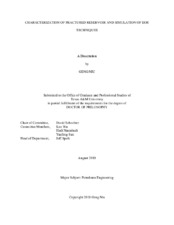| dc.description.abstract | Oil production from the fractured tight reservoirs has been increasing since the early 2000s and now accounts for a large portion of onshore US oil production. Complex fracture network composed of hydraulic fractures and natural fractures plays an important role in well depletion, but its geometry and properties have large uncertainty. On the other hand, different methods to improve oil recovery in the fractured tight reservoir have been tested in labs and fields recently. Although people generally understand the micro-mechanisms of these methods, the impact of fracture network on production enhancement has not been systematically studied. In this study, unstructured gridding algorithms are improved to apply to the reservoir with high fracture density. Then the depletion behavior of the dual-porosity methods and the discrete fracture network (DFN) method are compared based on the conceptual model, demonstrating the necessity of using DFN method in the fractured tight reservoirs. In terms of DFN application in real formations, microseismicity (MS), core observation, pumping schedule, outcrop map, and FMI log are used to characterize their fracture network geometry. History match is done to calibrate the reservoir models, which can gain confidence in using the DFN models for further study. To model EOR techniques in field scale, micro-mechanisms revealed from lab experiments about surfactant imbibition and COv2 huff n’ puff are used to generate appropriate simulation parameters. A series of surfactant spontaneous imbibition and COv2 huff n’ puff simulations are done on those calibrated models to study the EOR performance and seek the optimal operation parameters. Simulation results show that dual-porosity methods cannot take the transition flow between fracture-matrix into account, and cannot accurately model the discontinuity feature of fracture networks, which are critical to EOR performance. After calibration, DFN dynamic fluid flow models can approximately match the production data. Surfactant spontaneous imbibition simulation shows a marginal production increase compared to water imbibition cases. It is found that wettability alteration incurred in the fracture system could play a more important role in production enhancement, compared to the wettability alteration incurred in a small range of matrix. Simulation results of COv2 huff n’ puff indicate injection pressure and injection schedule impact the recovery performance. This study proposes a workflow to build reliable DFN models to represent fractured tight reservoirs with the use of multiple data sources. Furthermore, the performance of EOR technics is investigated with various scenarios. It is found that fracture geometry significantly affects depletion and EOR performance, so that appropriate field-scale simulation, in addition to corescale experiments, is recommended for EOR pilot design. | en |


